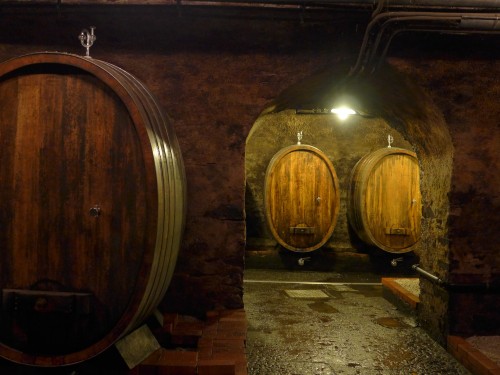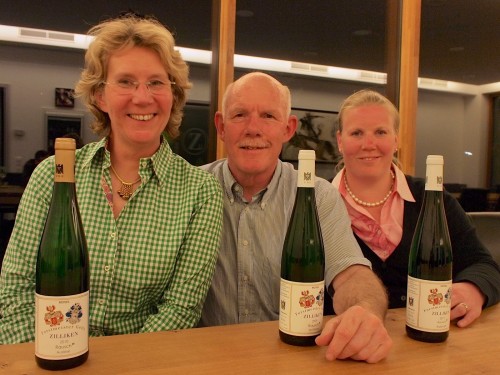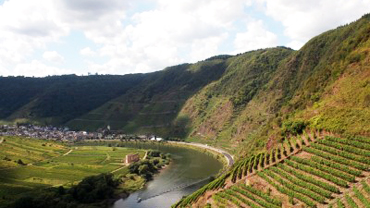Riesling Report Part I: In Mosel and Nahe, 2015 Rieslings shine in the glass
2015 is a significant vintage for Germany for a number of reasons that go well beyond a stellar harvest throughout the nation’s 13 wine growing regions. The most important of these is that it looks almost certain to be a global, breakout vintage for new high-end dry wines, the GGs (or Grosses Gewächs). Rightly so, because these wines are not only delicious and distinctive, but can be drunk in the same dining situations in which Chablis and other elegant, non-oaky Chardonnays are natural choices. Even more, the special balance of fruit, body, and acidity enables high-end dry Riesling to marry much better with spicy foods (in particular dishes with intense chili, ginger and/or Sichuan pepper) than Chablis & Co.

The barrel cellar at the Heymann-Löwenstein estate in Winningen (Photo credit: Stuart Pigott)
The GG category of dry wines was introduced by the national VDP producers association with the 2002 vintage. All GGs are single vineyard wines, and the name of the wine is the vineyard name just as it is for a Chablis Grand Cru Les Clos. As with those wines, it is the name of the vineyard in combination with the name of the producer that’s crucial. For example, I would rather have a Chablis Grand Cru from Dauvissat than from another producer. In this case, the question is, for example, not only if you like the type of fragrant and filigree Riesling that comes from the Sonnenuhr site (full name: Wehlener Sonnenuhr) in the Mosel, but if you prefer the Sonnenuhr from Dr. Loosen, for example, or that from another producer. The final factor when making the choice is vintage. Thankfully, with 2015, it’s hard to go wrong when you’re picking from the Mosel or the Nahe.
It’s worth noting that this new category of dry Rieslings would already be popular if it weren’t for the lingering impression among older consumers that anything from Germany or with Riesling on the label (regardless of it’s place of origin) is sweet and can’t be taken seriously. That’s the long dark shadow of the global fashion for cheap and sweetish Liebfraumilch, a trend that started tanking 30 years ago and now belongs to ancient history. Young consumers lack this prejudice, but still seem unaware that contemporary German wines and of Riesling everywhere are predominantly dry. But with the 2015 GGs and similar single-vineyard dry Rieslings rich in character and energy, these wines are a wake up call to the global markets.

Ruth, Hanno, and daughter Dorothee Zilliken of the Zilliken estate in Saarburg on the Saar (Photo credit: Stuart Pigott)
Of course, the light-bodied “classic” Rieslings with natural grape sweetness from the Mosel Valley continue to feature big in German wine exports, not least because many of them are stunningly aromatic and brilliant in flavor. But even the Mosel has rediscovered dry Riesling since the last turn of the century. I say “rediscovered” because if you turn the clock back another century to just after 1900, when Mosel Rieslings were the most sought after whites in the world, a great majority of them were dry. The light and sweet “classic” Mosel Rieslings only became commonplace after the introduction of affordable sterile filtration technology in 1949.
This dry Mosel Riesling story is more exciting still, because the leading producers of the Mosel are working hard to catch up with their southern colleagues in the nearby Nahe region. Vintners there have had major success on the domestic market with their dry Rieslings. Look at the scores I’ve given to the GGs from top producers like Schlossgut Diel, Dönnhoff, Emerich-Schönleber and Schäfer-Fröhlich and you’ll see why. Indeed, the excitement about these wines isn’t just the result of hype, but rather consumers have recognized their stunning quality. Some of these are harder to find in Germany than in New York or Hong Kong!
The similarities between the Mosel and Nahe regions are striking, and they make this battle for recognition and commercial success entirely logical. Both are river valleys with steep vineyards and stony soils, and in both, the most important grape for quality white wines is Riesling. The top vineyard sites of the Mosel nearly all have slate soils, whereas the best vineyards of the Nahe have slate, red sandstone or volcanic soils like porphyry.
It may be easier to make a pleasant dry Riesling for everyday drinking from richer and more water-retentive soils (particularly in the Nahe which has much less rainfall than the Mosel), but if the grower does everything right in the vineyard, then the combination of steep southerly slopes and stony soils gives wines a unique racy excitement.

The Terrassen Mosel, or terraced section of the Mosel Valley that is home to Clemens Busch and Heymann-Löwenstein (Photo credit: Stuart Pigott)
About the Mosel
The Mosel has fully 5,363 hectares of Riesling, which represents 61% of the entire vineyard area, and the Nahe has 1,181 hectares of Riesling, 28% of all the region’s vineyards. Compare these with the national average of 23% Riesling in Germany’s vineyards. It’s worth pointing out that Weissburgunder (Pinot Blanc) and Grauburgunder (Pinot Gris) are important specialties for the Nahe, whereas they’re small sidelines for the Mosel.
The typical alcoholic content of the dry Riesling GGs lies between 12.5% and 13%, down about 0.5% from a decade ago. Today most producers are looking for a combination of flavor intensity and balance. The wines also taste drier than they did back then, and I have only mentioned sweetness where a hint of it is easily perceptible. Otherwise these are all properly dry wines.
I have broken the Mosel and the Nahe up into their sub-regions to help with orientation. The Terrassen Mosel, or Terrace Mosel, is the new name for the lower section of the valley. There the steep vineyards are all made up of narrow terraces like those in the Northern Rhône Valley of France, hence the name.
-Stuart Pigott